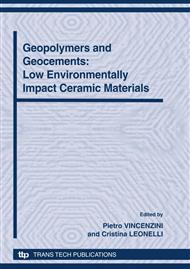p.97
p.107
p.117
p.123
p.129
p.135
p.143
p.152
p.156
Formation of Tetra-Coordinated Aluminum in the Low Temperature Ashes
Abstract:
Formation of tetra-coordinated aluminum in low temperature coal ashes was investigated. Coal samples were intensively air-oxidized at 350oC for 160 hours, then 27Al MAS NMR spectra of obtained ashes were acquired and compared against those for initial coals, a reference ash and Al standards. It was found that chemical shift at 4 ppm with coals corresponds to that for triaquohydroxo- diphenoxido-aluminum(III) complex and the shift at 72 ppm with resulting coal ashes agrees with that for Al tetra-coordinated with oxygen. So, in the presence of coal organics the tetracoordinated Al is formed under low temperature conditions. Formation of this form of Al can be elucidated as follows. Probably, Al in coal originates from kaolinite, as this mineral is very frequent in coal. Mentioned Al-complex was formed through the long-term reactions of kaolinitic hexacoordinated Al with phenols/polyphenols as prevailing oxygen-contaning components in coal substance. During this process the octahedral structure of hexa-coordinated Al was retained, but ligands coordinated around the central Al atom changed. At first, delamination of a kaolinitic structure through the effect of coal organics proceeded and separation of the Al gibbsite octahedral and silica tetrahedral layers occurred. Then, two oxygens in the Al octahedron were substituted with two phenoxide groups while OH groups were preserved. As result, Al-tetrahydroxo-diphenoxide ion was formed, further stabilized in a water environment as Al(H2O)3(OH)(C6H5O)2. During low temperature ashing this complex was transformed to Al tetra-coordinated with oxygen only at 350oC.
Info:
Periodical:
Pages:
129-134
Citation:
Online since:
October 2010
Authors:
Keywords:
Price:
Сopyright:
© 2010 Trans Tech Publications Ltd. All Rights Reserved
Share:
Citation:


